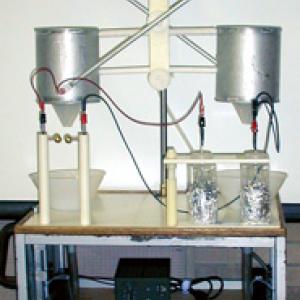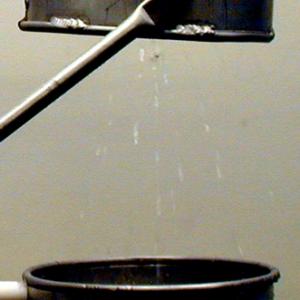College of Liberal Arts & Sciences
5A40.70 - Kelvin Water Dropper - Relaxation Oscillator
The Kelvin Water Drop App. can be a little touchy at times. It seems to work best if you set up the apparatus and run the water at least 12 hours in advance. You can run the water direct from the faucet and get good results but you will need the 5 gal. bucket and pump with power supply if a faucet is not available. (ie. Rm 301). You need to regulate the water flow so that the stream splits into droplets in the region of the top ring of the apparatus. This is about in the 30 volt region if using the pump. As the charge is building up the streams will start to repel each other, eventually building up enough charge to shoot the streams outside the bottom can of the apparatus. The spacing of the spark gap will determine the amount of charge buildup.
NOTE: The streams will look continuous unless you look at them with a strobe. You can also see this effect by looking through the streams at a TV set!! When the apparatus gets going a 1/2 inch spark every 30 to 60 seconds should be possible.
We have a variety of relaxation oscillators available. Look at these webpages:
3A95.10 - Relaxation Oscillators
6-00.00 - Stroboscope (we have small variable frequency strobe lights available).
2B60.30 - Tantalus Cups
3D32.15 - Stadium Horn
4C30.25 - Geyser
4C31.30 - Drinking Bird
4C31.37 - Franklin's Pulse Glass Engine
5A40.70 - Kelvin Water Dropper
5F30.60 - Relaxation Oscillators - Neon Bulb, Doorbell, and Strobe Lights
10A06.10 - Relaxation Oscillators
13A10.10 - Perpetual Motion
- Se-yuen Mak, "The Kelvin Water-Drop Electrostatic Generator-An Improved Design", TPT, Vol. 35, # 9, p. 549-551, Dec. 1997.
- Paul Chagnon, "Animated Displays VI: Electrostatic Motors and Water Dropper", TPT, Vol. 34, # 7, Oct. 1996, p. 491.
- Karen Brecher, "The "VideoStrobe" Water Drop Gravimeter", TPT, Vol. 28, # 2, Feb. 1990, p. 108.
- Clifford Bettis, "Deck the Halls: The "Ting-a-Ling" Machine", TPT, Vol. 26, # 5, p. 340, May 1988.
- Michael Sady, "The Kelvin Water Dropper: An Elementary Experience", TPT, Vol. 22, # 8, Nov. 1984, p. 516 - 517.
- William Blunk, "Kelvin Electrostatic Generator Workshop", TPT, Vol. 20, # 6, Sept. 1982, p. 412 - 413.
- J. T. Lloyd, "Lord Kelvin Demonstrated", TPT, Vol 18, # 1, Jan. 1980, p. 16.
- Lester Evans, J. Truman Stevens, "Kelvin Water Dropper Revisited", TPT, Vol. 15, # 9, Dec. 1977, p. 548.
- Menno Fast, "Electrostatic Lobby Display", TPT, Vol. 10, # 2, Feb. 1972, p.100.
- Thomas B. Greenslade, Jr., "Armstrong's Hydroelectric Machine", AJP, Vol. 92, #5, May 2024, p. 348.
- Vladimir Grubelnik, and Marko Marhl, "Drop Formation in a Falling Stream of Liquid", AJP, Vol. 73, # 5, May 2005, p. 415.
- Gorazd Planninsic, Tomaz Prosen, "Conducting Rod on the Axis of a Charged Ring: The Kelvin Water Drop Generator", AJP, Vol. 68, # 12, p. 1084, Dec. 2000.
- Markus Zahn, "Self-Excited AC High Voltage Generation Using Water Droplets", Vol. 41, #2, Feb. 1973, p. 196.
- Ea-14: Freier and Anderson, A Demonstration Handbook for Physics.
- E-25: Richard Manliffe Sutton, Demonstration Experiments in Physics.
- C.L. Stong, "Concerning Experiments with Rubber and How to Re-Create a Classical Electrostatic Generator", The Amateur Scientist, June, 1960.
- Robert A. Morse, " # 5, The Kelvin Water Dropping Generator", Teaching about Electrostatics, p. 4 - 6.
- Jearl Walker, "5.13, Danger of Spraying Water", The Flying Circus of Physics Ed. 2, p. 224.
- 6.8, Jearl Walker, "Kelvin Water Dropper", The Flying Circus of Physics with Answers.
- "200, Kelvin Water Dropper", Christopher P. Jargodzki and Franklin Potter, Mad About Physics, p. 75, 216.
- John Vanderkooy, "An Electrostatic Experiment of Lord Kelvin with Running Water", Physics Department University of Waterloo, Waterloo, Ontario, Canada N2L 3G1.
Disclaimer: These demonstrations are provided only for illustrative use by persons affiliated with The University of Iowa and only under the direction of a trained instructor or physicist. The University of Iowa is not responsible for demonstrations performed by those using their own equipment or who choose to use this reference material for their own purpose. The demonstrations included here are within the public domain and can be found in materials contained in libraries, bookstores, and through electronic sources. Performing all or any portion of any of these demonstrations, with or without revisions not depicted here entails inherent risks. These risks include, without limitation, bodily injury (and possibly death), including risks to health that may be temporary or permanent and that may exacerbate a pre-existing medical condition; and property loss or damage. Anyone performing any part of these demonstrations, even with revisions, knowingly and voluntarily assumes all risks associated with them.


